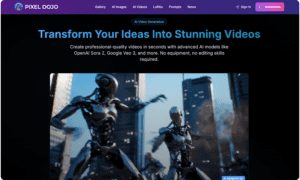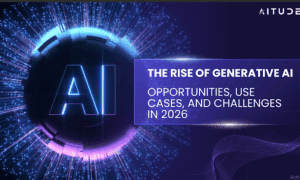We initially thought AI would someday replace manual workers. However, it is actually the knowledge workers who are facing the most notable impact today. There are two different and separate perspectives on AI. Some fear their jobs with the application of AI, while others are eagerly incorporating AI into workflows. One thing, however, is absolutely certain. Generative AI is here to stay, and it is absolutely booming.
This article delves deeper into the inner workings of Generative AI and its advantages.
1. What is Generative AI?
Generative AI refers to a type of artificial intelligence technology that can bring out various kinds of content, such as audio, text, imagery, and synthetic data. It involves deep learning models that tend to generate high-quality images, text, and other content based on the data that they were trained on.
The recent news around generative AI is driven by the simplicity of new user interfaces for the creation of high-quality graphics, text, and videos in just a matter of a few minutes.
In simpler terms, generative AI tends to describe algorithms that can be used for content creation, including code, audio, text, videos, images, and simulations. Recent breakthroughs in this field have the ability to radically change the way content creation is approached.
It is a form of machine learning that allows computers to generate exciting content, from art and music to virtual worlds. It is not only for fun – it has many other practical uses as well, such as the creation of new product designs and optimization of business processes.
2. How Do Generative Models Work?
Generative AI functions by utilizing deep learning in order to build models from a provided training data set. These models are trained on the recognition of data patterns and the generation of new data on the basis of these patterns. In simpler words, generative AI begins with a prompt, which can be in text, image, video, design, musical notes, or any other form that the AI system can process.
Then, different AI algorithms tend to return fresh content in return for this prompt given. This content can be anything ranging from solutions, essays, or even realistic fakes that are created from audio or pictures of a person.
3. Real Applications of Generative AI Models?
Generative AI models have a wide range of real-world applications in different industries. Some of the most basic real applications of these models include the following:
3.1 AI for Text Generation: ChatGPT
ChatGPT is the perfect example of how AI can be utilized for text generation. It is the process whereby natural language text is automatically created from distinct data input based on LLM (large language models). It is being utilized for the creation of different forms of written content, such as social media copies, blog posts, emails, and much more.
This AI feature can be used by small and large business owners alike for writing blog posts and other relevant content that can be generated in just a few seconds. They can acquire the required text by simply putting in relevant prompts such as the topic, tone, and main points.
3.2 AI for Image Generation: Midjourney
Another real application for generative AI models is image generation, whereby it can be used to generate images in computer graphics, digital art, medical imaging, or simply for fun. Midjourney is one such example of an AI image generator that can generate realistic images within a few minutes based on a prompt given.
3.3 AI for Video Generation: Virbo
The best usage for generative AI is the creation of videos with talking avatars, which can be used for different purposes ranging from training and marketing to corporate communications and much more. Different industries can use this feature of generative AI models for different purposes.
For instance, content marketers generally face challenges coming up with ideas or projects that would make them stand out in a saturated market. Virbo offers to generate content using talking AI avatar video to capture the audience’s attention. If content creators ever encounter a mental block, they can enable the AI Script feature which allows in creating excellent content relevant to the topic.
Also, freelancers can also craft videos for their clients in a short amount of time using the Template Library.
Moreover, the high-quality software supports more than 300 voices and languages along with hundreds of multinational AI avatars. The editor is quite extensive, allowing you to insert more scenes, adjust the background and manage the subtitles. The Timeline Mode makes it easy to edit.
More importantly, it is a cross-platform tool, available for Desktop, Mobile App, and Web. Try it now!
4. Benefits of Generative AI
Generative AI is applicable extensively across different business areas. It makes it easier to understand and interpret the existing content, automatically developing new content. Developers are also exploring distinct ways in which generative AI can be used to improve the current workflows, with an eye toward adaptation of new workflows.
Here are a few potential advantages of generative AI:
- Automation of writing content’s manual process
- Reduction in the efforts of responding to emails
- Improving responses to particular technical queries
- Creation of realistic representations of people
- Summarization of complicated information into a coherent narrative
- Simplification of the process of content creation in a particular style
5. The Future of Generative AI
ChatGPT brought immense depth and ease with it, which led to the widespread adoption of generative AI. This speedy adoption of this technology has also demonstrated some difficulties in the responsible and safe rollout of technology. However, these initial implementation issues have inspired research to create better tools for the generation of AI-generated images, text, and videos.
The popularity of different tools such as ChatGPT, Midjourney, and Virbo has fueled an intriguing interest in the area. In the future, it is predicted that generative AI will continue to evolve, making remarkable advancements in drug discovery, translation, anomaly detection, and generation of new content, from video and text to music and fashion design.
The most significant impact of this technology will come from the integration of the capabilities directly into tools that are already used. For instance, grammar checkers will become more advanced. Design tools will smoothly embed useful recommendations directly into the workflows. Training tools will become more efficient, and much more will be achieved.
The impact of generative AI in the future world is very difficult to say. As we continue to harness all these tools to augment and automate human tasks, it is inevitable that we find ourselves reevaluating the value and nature of this human expertise.
Read More From Techbullion



































